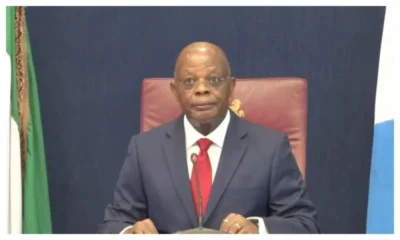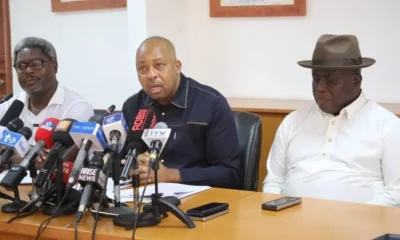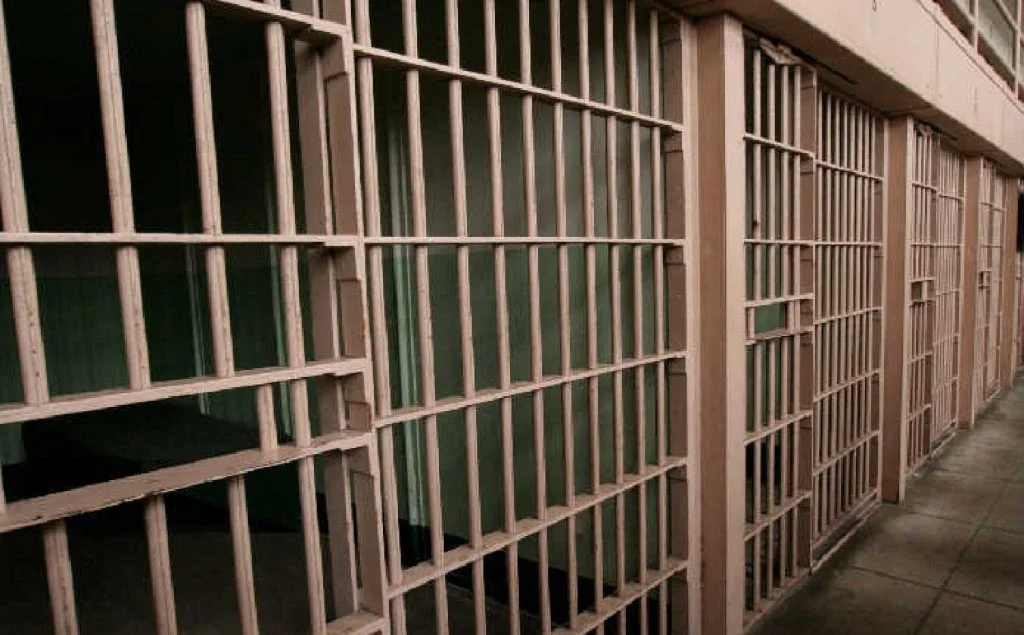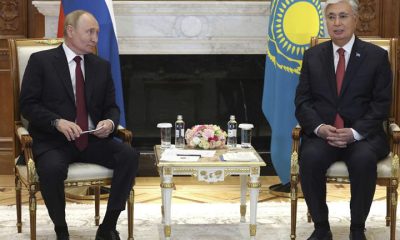Trending
Israel-Lebanon crisis: Lebanese ramp up humanitarian efforts
Published
6 months agoon
By
Ekwutos BlogAmid Israeli strikes and limited public aid, Lebanese activists are jumping into action. However, observers point out that aid is being politicized, and there are too many in need.
Almost three weeks into Israel’s devastating strikes on Lebanon, civilians are increasingly taking the organization of humanitarian help into their own hands.
“I joined a local initiative, and we distribute donations between several shelters and schools,” Rayan Chaya told DW in Aley, some 20 kilometers (12 miles) southeast of Beirut.
The 27-year-old mechanical engineer has been setting up databases with places to rent and eat for free. He also organized a wheelchair for a family who had to leave theirs behind when they fled.
“We’re in a crisis, and if we don’t help each other, who will?” he said. “The government isn’t taking any serious action.”
Heiko Wimmen, Lebanon project director at the International Crisis Group, a non-governmental conflict prevention organization, confirms this view.
“The level of humanitarian support for the population is what you would expect from a country whose political structures do not really function,” he told DW.
Years of political instability in combination with an ongoing economic crisis have left Lebanon on the brink of collapse.
The dire situation was further exacerbated in late September when Israel escalated its attacks on Hezbollah, designated as a terrorist organization by several countries, including the US and Germany, while the EU classifies its armed wing as a terrorist group, after a year of limited fighting.

Israeli attacks have not only killed several leading Hezbollah members but also around 2,000 civilians, according to the Lebanese Health Ministry
© Daniel Carde/ZUMA/picture alliance
Since then, several Hezbollah leaders have been killed and more than 2,000 civilians have died in the Israeli attacks, according to the Lebanese Health Ministry.
Some 608,000 people are currently internally displaced according to the latest update by the UN Office for the Coordination of Humanitarian Affairs (OCHA). According to Lebanese authorities, this number is twice as high.

House squatters on the rise
Meanwhile, the Lebanese government, which acts in a caretaker capacity, has set up 973 shelters in public institutions across the country. Yet, the available 180,000 places were quickly taken.
“The number of shelters doesn’t match the number of needed places and I fear that house squatters will increasingly take over both emptied apartments as well as uninhabited luxury flats,” Wimmen said.
According to a study by Beirut’s American University, around 31% of Beirut’s property has been bought for investment purposes.
Meanwhile, Lebanese who are affiliated in one way or the other with Hezbollah’s influential political wing are increasingly moving into these apartments.
“Some of the Hezbollah-affiliated parties such as the Amal [Movement] and the Syrian Socialist National Party [in Lebanon], who have been doing the dirty work on behalf of Hezbollah for years, have opened buildings for refugees,” Crisis Group’s Wimmen said.
The Washington Post reported earlier this week that a spokesman for the Lebanese police told their reporter that they would empty the buildings only when proper alternatives were found.

Volunteers work in a community kitchen to prepare meals for those who fled Israeli bombardment in southern Lebanon
© ANWAR AMRO/AFP
Food, clothes, and a hug
Mosques, churches, bars and many private people do their best to help, Anna Fleischer, director of the Heinrich-Böll-Stiftung Middle East Office in Beirut, told DW.
“In my mosque, there is no space to host families but the number of worshippers has increased immensely and we provide food, medical services and relief,” Sheikh Mohammed Abu Zaid, imam of the largest mosque in Saida, 45 kilometers south of Beirut, told Ekwutosblog.




Sally Halawi, who owns the thrift shop “Circuit” in Beirut, has also decided to help refugees.
“I felt I had to do something to help,” she told DW. She donated everything in her shop to people who had left their homes and belongings behind. On Instagram, she called out for more donations.
“Lots of people responded,” Halawi recalls. Every morning, she assembles the donations according to gender and size. Every evening, donations are sent to the school-turned-shelters.
“So far, we have collected more than 30,000 items,” the 35-year-old said, adding that “as draining and hectic as this is, I believe this is the least I can do for my people, and I still feel it’s not enough.”
Humanitarian aid bridge
Meanwhile, international humanitarian aid for Lebanon’s population is picking up.
On Friday, the first of three flights with EU-owned stocks including hygiene items, blankets and emergency shelter kits is set to arrive in Beirut. France and other EU offices have also sent supplies.
Earlier this week, Health Minister Firas Abiad welcomed 40 tons of medical supplies from the United Arab Emirates.
And yet, observers stress that addressing the humanitarian crisis in Lebanon is also driven by political interests.
“Lebanon’s ruling elite is now trying to maintain its dominance by courting international donors as well as Western and Gulf Arab sponsors,” Lorenzo Trombetta, a Middle East analyst, told DW.
The first to promise humanitarian aid were Qatar and the United Arab Emirates, he added.
However, Qatar has been hosting the political Hamas elite for years and is one of the key negotiators for a cease-fire in Gaza.
“And Abu Dhabi supports the alliance with the United States and collaborates with Israel and its armed forces on high-tech technology, as well as continuing to send aid to Beirut,” Trombetta explained.
In his view, this is done to “exert greater political influence in Lebanon and strengthen its presence in the Eastern Mediterranean.”
He also fears that Lebanon’s political elite is about to deprioritize the needs of the population. “In the near future, the main focus will turn to the management of reconstruction funds,” Trombetta warned.
He considers it key to link reconstruction aid as well as the distribution of essential services and welfare exclusively to Lebanon’s civil population.
However, that aid effort appears to be stalling. The UN-led flash appeal for over $426 million (€389 million) for Lebanon’s civil society has so far received only $53 million.
Edited by: Rob Mudge
You may like


Kano deputy gov reports back after peace-building mission in Edo


Despite criticism, Ibas swears in sole administrators for Rivers LGAs


Kano lawyer petitions Tinubu over ‘politically motivated’ police invitation of Emir Sanusi


U.S withdraws military aid from Niger, redirects to Côte d’Ivoire, Benin, Ghana


FCT Minister rolls out major land administration reforms, introduces strict timelines for allottees


Atiku, El-Rufai, Tambuwal visit Buhari in Kaduna
Trending
Moment helicopter crashed into Hudson River in New York (VIDEO)
Published
10 hours agoon
April 11, 2025By
Ekwutos Blog
Footage has emerged of the ill-fated helicopter that crashed into Hudson River on Thursday afternoon.
The helicopter that crashed into the River in New York City killed all six persons on board.
The deceased include the pilot and a visiting family of five from Spain, among them three children.
The aircraft, identified as a Bell 206, had taken off from Manhattan less than 30 minutes before the crash.
New York City Mayor Eric Adams confirmed that all six bodies have been recovered.
Emergency responders pronounced four victims dead at the scene, while the remaining two succumbed to their injuries at a nearby hospital.
The FAA’s statement reads: “A Bell 206 helicopter crashed and is submerged in the Hudson River in New York City. The number of people on board is unknown at this time. The FAA and the National Transportation Safety Board will investigate. The #NTSB will lead the investigation and provide any updates.”
Trending
Senator Natasha Responds To Akpabio’s Defamation Petition To Police IG, Cites Fear For Her Safety
Published
13 hours agoon
April 11, 2025By
Ekwutos Blog
But Senator Akpoti-Uduaghan, speaking through her legal counsel Victor Giwa, said her comments were not made for political leverage but out of genuine fear for her safety.
The suspended senator representing Kogi Central, Natasha Akpoti-Uduaghan, has strongly responded to a formal petition filed by Senate President Godswill Akpabio, in which she is accused of criminal defamation and incitement over allegations of an assassination plot.
But Senator Akpoti-Uduaghan, speaking through her legal counsel Victor Giwa, said her comments were not made for political leverage but out of genuine fear for her safety.
“She has received the petition and has responded,” Giwa said. “What happened when she made that statement was her crying out to the general public to understand what she is exposed to.”
Giwa also criticised what he called a deliberate act of endangerment by Senate leadership, alleging that Natasha’s security details were withdrawn immediately after her suspension.
“You are aware that the Senate President ordered the withdrawal of her security,” Giwa noted.
“If somebody has committed gross misconduct, what has that got to do with the withdrawal of her security? She is a politically exposed person. You stopped her from entering the Senate, fine. But she has a life outside the complex. She is entitled to protection.”
Senator Akpoti-Uduaghan was suspended from the Senate for six months under controversial circumstances earlier this year.
Ekwutosblog on Thursday reported that Senate President Godswill Akpabio had formally petitioned the Inspector General of Police, Kayode Egbetokun, seeking an investigation into an alleged assassination plot made against him by Senator Akpoti-Uduaghan.
In the petition dated April 3, 2025, Akpabio denied the serious accusation and called for the prosecution of Akpoti-Uduaghan for criminal defamation.
The petition, which was also copied to the Attorney General of the Federation and Minister of Justice, Lateef Fagbemi (SAN), comes after Akpoti-Uduaghan’s public outburst on April 1, 2025.
During a speech in Kogi State, Akpoti-Uduaghan accused Akpabio of instructing former Kogi State Governor Alhaji Yahaya Bello to assassinate her in Kogi State, claiming that the act was intended to make it appear that her constituents were responsible for her death.
Akpabio categorically denied the accusation, calling it a “heinous lie” and a “reckless and deliberate attempt” to tarnish his reputation.
In his petition, the Senate President labelled the allegation as politically motivated, accusing Akpoti-Uduaghan of attempting to incite political unrest and damage his public image.
He stressed that the allegation was made without any supporting evidence.
The Senate President also highlighted the severe impact of the false allegation, especially given its widespread coverage across media platforms, including radio, television, and social media. He urged law enforcement agencies to treat the matter with the seriousness it deserves.
He said, “I write to formally bring to your attention and seek immediate investigation and prosecution of a criminally defamatory and malicious statement made against me by Senator Natasha Akpoti-Uduaghan, a suspended member of the Nigerian Senate on the 1st of April, 2025 and which was widely publicised on radio stations, televisions and newspapers, including the social media.
“In the public outburst at Kogi State while addressing her audience, Senator Natasha Akpoti-Uduaghan falsely alleged that I instructed the former Governor of Kogi State, Alhaji Yahaya Bello, to “assassinate her in Kogi State instead of Abuja” with the intent of making it appear that her constituents were responsible for her death.
“This statement is not only a heinous lie but a reckless and deliberate attempt to damage my reputation, endanger my life and security, and incite political unrest.
“I categorically state that this allegation is entirely false, unfounded, and politically motivated. It is a calculated act of blackmail and character assassination, designed to portray me as a political villain, and the statement was made without any shred of truth or supporting evidence.”
He further added that the statement was intended to manipulate public sentiment and malign his person and office.
“Her motive was clear, which was to incite the public, manipulate sentiments, and malign my person and office in the eyes of the Nigerian people and the international community,” he said.
“The severity of this false allegation, and the fact that it has gained public traction, makes it necessary that law enforcement agencies treat it with the urgency it deserves.”
In the petition, Akpabio called for the “immediate investigation into the false and inciting allegation” and the prosecution of “Senator Natasha Akpoti-Uduaghan under the relevant provisions of the law for criminal defamation, incitement, false accusation, and conduct likely to cause a breach of peace”.
Trending
Owerri correctional facility dispels rumours of attack, jail break
Published
1 day agoon
April 10, 2025By
Ekwutos Blog
The prison authorities of Imo State Correctional Centre have dispelled rumours of a jailbreak at the Correctional facilities alleged to have been caused by Funali Herdsmen on a mission to free their brothers.
A press statement issued by the Public Relations Officer of the Centre, Chief Superintendent of Corrections, CSC, Goodluck Uboegbulam, informed that the alleged invasion by armed Fulani herdsmen as reported in the social media is entirely false and misleading.
Uboegbulam urged the public and security personnel to disregard the viral post, which he described as fake and unfounded.
“I wish to bring to our notice a disturbing fake news making the rounds on the internet about an attack on Owerri custodial centre. I want to assure everyone that the facility is calm and under control. All officers are on red alert, and there is no cause for alarm.”the release stated.
He hinted that the false report had claimed that over 50 armed herdsmen had stormed the Centre, freeing more than 70 inmates.
Our correspondent reported that there is calm within the facility when visited as normal security checks is still in place.
It was also gathered that there is heavy security surveillance, with an army armoured tank and personnel stationed at the facility’s entrance, as has been the case since the April, 1 , 2021 attack during the EndSARS protests.
The Correctional Service spokesperson used the medium to urge the public to disregard the report and avoid spreading unverified news.

Kano deputy gov reports back after peace-building mission in Edo

Despite criticism, Ibas swears in sole administrators for Rivers LGAs

Kano lawyer petitions Tinubu over ‘politically motivated’ police invitation of Emir Sanusi
Trending

 Trending6 months ago
Trending6 months agoNYA demands release of ‘abducted’ Imo chairman, preaches good governance
- Business6 months ago
US court acquits Air Peace boss, slams Mayfield $4000 fine

 Politics6 months ago
Politics6 months agoMexico’s new president causes concern just weeks before the US elections
- Entertainment6 months ago
Bobrisky transferred from Immigration to FCID, spends night behind bars
- Entertainment6 months ago
Bobrisky falls ill in police custody, rushed to hospital

 Politics6 months ago
Politics6 months agoRussia bans imports of agro-products from Kazakhstan after refusal to join BRICS

 Politics6 months ago
Politics6 months agoPutin invites 20 world leaders
- Politics1 year ago
Nigerian Senate passes Bill seeking the establishment of the South East Development Commission.

